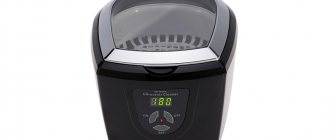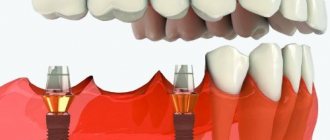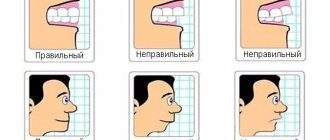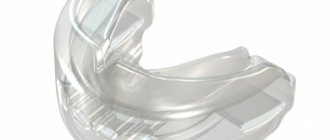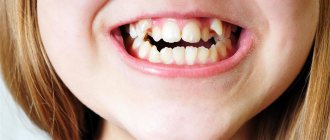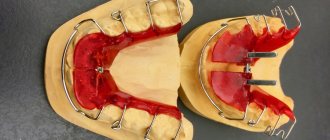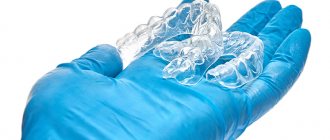How to correct your bite and achieve an attractive smile? Orthodontists know the answer to this question. Modern dentistry is developing at a rapid pace, but dental plates are still an effective treatment method. These orthodontic appliances are primarily designed to correct malocclusions in very young patients, although they are sometimes quite effective in adults.
Plates for teeth: removable and non-removable
In dentistry, doctors work with different types of orthodontic products. At the initial appointment, the orthodontist will tell the young patient and his parents what the plates for straightening teeth are called, how they differ and what they are like. The most popular:
- systems – single-jawed, with a retraction arch, with a pusher, with a hand-shaped process;
- devices – Brückle, Frenkel;
- Andresen-Goipl activator.
Products are divided according to the method of fixation:
- removable – hypoallergenic polymer construction includes wire hooks and arcs for fixing the plate;
- non-removable – they look like metal brackets that put pressure on the teeth from the outside, forming the correct bite.
A removable dental plate is placed on children to correct simple bite defects. The optimal age of a child for correction is 5-12 years. Fixed products can compete in effectiveness with braces; they are usually recommended for teenagers to eliminate serious anomalies of the dentition.
Braces are non-removable orthodontic structures in which a plate is placed on each tooth, and an arch with a “memory effect” is responsible for correcting the bite. Metal braces are the most effective, but sapphire and ceramic braces are almost invisible on the teeth. There are also ligature braces with rubber bands and self-ligating ones, which reduce the treatment period by several months.
What is better: braces or plates?
You can choose dental plates or braces for a course of treatment only after an examination in the orthodontist’s office, following his recommendations. The structures influence the formation of the bite, but the mechanism of their action is different.
Dental plates
There is no lower age limit. They can be used in preschool age, when the child is already able to cooperate with the doctor. These are removable models.
The active element is arches that help the teeth take the correct position in the row. But the effect of the device on molars is limited. The design can prevent further bite deformation. Listen to your dentist's recommendations. Often, timely measures taken during a sensitive period help to avoid problems that will begin in a few years if there is no intervention.
In children, this orthodontic instrument allows you to change the width of the palate or restrain the development of pathological processes. It also prepares the jaw apparatus for the installation of braces in the future in case of a serious anomaly. In difficult cases, plates can be used until the molars appear, and then, in adolescence, braces need to be installed.
Braces
Any brace system is a non-removable structure. Installation and removal of braces is possible only in the office of an orthodontist. The system is capable of correcting complex combined malocclusions. Braces can be installed only from 11-13 years of age if most molars are present.
Properly installed braces:
- eliminate crowding of teeth,
- adjust the gaps between them,
- change the relative position of the jaws - stimulating or inhibiting their development.
When correcting complex anomalies, the child may need to wear a plate or retainer after braces to secure the result.
Adults and children
Dental plates are installed for children with milk units. During this period, the baby’s bite is formed, and the teeth are gradually replaced by permanent ones. Sometimes minor defects begin to progress and timely actions of the orthodontist will prevent the problem or prepare the jaw apparatus for gentle treatment. Dental plates are not used to change the bite of adults. This orthodontic instrument is needed to maintain results after wearing braces.
Does a plate straighten teeth: indications
Children are prescribed plates for the lower teeth and expansion plates for the upper and lower teeth only after a thorough diagnosis. Based on X-ray and panoramic photographs, measurements and study of proportions, the orthodontist decides to place a plate on the child’s teeth.
Treatment is indicated for:
- minor and serious anomalies of dental bite;
- violation of the tone of individual muscles;
- pathologies of tooth growth in the upper or lower jaws;
- incorrect position of incisors and canines;
- disproportionate growth and development of the dentofacial rows.
Orthodontic removable appliances equalize the growth rate of the jaw bones, straighten teeth in given planes, and correct the closure of the jaws.
Marco Rosa apparatus
The Marco Rosa apparatus is a non-removable expansion apparatus that is fixed to the palate and supported by temporary teeth. Pros - quick adaptation (including with diction), maximum aesthetics (absolutely invisible to others), rapid expansion of the upper dentition (achieved in just 1 month, then 6-8 months for stabilization), work efficiency regardless of cooperation with the patient (after all, the device cannot be removed independently). The only caveat is that oral hygiene must be excellent (it is necessary to thoroughly clean the teeth and the apparatus itself using a brush-paste and irrigator).
What do children's dental plates look like?
A plate made in a pediatric dental laboratory is a standard of aesthetic perfection. Any shades, gradient colors, sparkles and bright decorations inside translucent plastic - children are delighted when they see it for the first time.
Structurally, the plate is:
- the base is strong and quite rigid;
- elastic wire - fasteners, arches and hooks are made from it, and it is this wire that provides the necessary pressure to correct the bite;
- the screw is an activator responsible for pressure and intensity of impact.
The screw is tightened by the doctor with a special key, or this is done by the parents according to the correction plan drawn up.
Soldatenkova Alina
I am often asked how dental plaques are made for children. First, we take impressions of the teeth – it doesn’t hurt, but sometimes it’s a little unpleasant. Then, based on the impressions, the appliance prescribed by the orthodontist is manufactured in a dental laboratory. Then try it on and create a design that is comfortable to wear. And issuing a plate to the patient with recommendations for wearing
How to wear dental plates - recommendations for children and parents
Whether dental plates help is the main concern of parents. Much depends on how correctly the young patient wears the orthodontic apparatus.
The main requirements for wearing orthodontic plates:
- duration – up to 20-22 hours daily;
- care - morning and evening cleansing with pastes, gels, weekly deep cleansing in a special solution;
- remove the product when eating;
- Do not play with the orthodontic appliance - remove it and return it to its place in the mouth with your tongue.
The doctor will show you how to put the plate on your teeth at your appointment, but there is nothing complicated about it. Metal arches fix the structure, and the regulatory elements are responsible for gentle correction of the bite while wearing.
It happens that a child takes the product out of his mouth, and then cannot figure out how to put the plate on his teeth - it either falls off or does not fit into place. Such a circumstance may be preceded by the following events:
- the device was in the mouth for less than 12-14 hours a day, and the fixation was broken;
- supporting units have been removed or fallen out – the structure requires orthodontic correction;
- a tooth erupts under the polymer part of the system and prevents it from taking the correct position;
- the plate was not worn for several days in a row - the bite has returned to its original position and you need to see a doctor to adjust the device;
- violation of medical recommendations for wearing removable plates - it is worth coming to an appointment and checking the condition of the product.
Until what age can teeth be straightened with a plate?
Until what age do plates be placed on teeth is a question to be decided on an individual basis. Some devices work best during the period of active changes in occlusion, so they are recommended to be worn until 10-11 years of age. Other products perform well until the teeth completely change - up to 12-14 years. But the doctor assesses the situation more fully.
Often, orthodontists use a combined treatment method - changing devices, selecting new ones for the current situation. That is why it is not always necessary to delve into the names of plates for straightening teeth. The result is important, not what the dental plates are called.
It is difficult to answer how long a plate is worn on the teeth. Some patients require full-time braces and additional treatment with braces at age 14. For others, the situation improves in 1-2 years.
During an orthodontic consultation at Aza&Buka, patients will receive complete information about the treatment. The doctor will not just show a photo of an orthodontic children’s dental plate, but will also conduct an initial diagnosis, tell you the features of the planned correction, the approximate duration of treatment, and prospects. While the adults are talking, children can get acquainted with the variety of orthodontic devices - choose the color of the plate for the teeth and the design.
Conclusions. Expert advice
The vestibular plate is a simple and effective method for correcting malocclusion and speech problems at an early age. It helps get rid of the following problems:
- mouth breathing and poor development of nasal breathing;
- low tone of the orbicularis oris and lingual muscles;
- speech defects, infantile type of swallowing, incorrect development of the jaws.
Wearing the product helps stimulate natural self-regulation processes, so the capabilities of the plates are limited. But choosing one of the modifications will help expand them. The following types of records exist:
- standard,
- with damper,
- with a bead,
- with a visor.
Each has additional capabilities and specifics. For example, a model with a bead is recommended mainly by speech therapists, and a plate with a visor is recommended to be worn for abnormalities in the development of the jaws.
You should not buy vestibular plates for children without a doctor’s recommendation. It is better to visit an orthodontist so that he can confirm the need for the product and that it will not cause harm. Also, be sure to keep the product clean: wash it regularly and treat it with an antibacterial agent.

